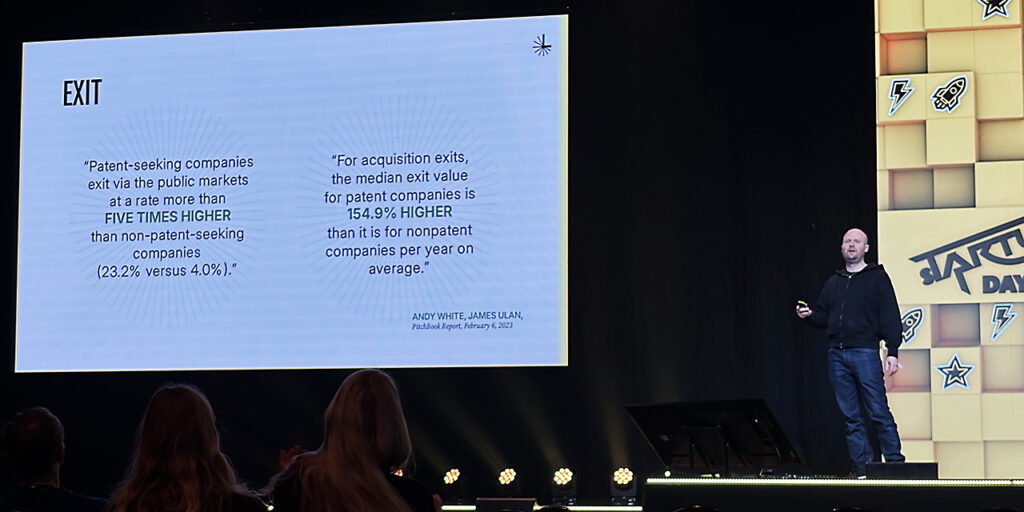Deep tech startups operate at the forefront of scientific and technological breakthroughs, requiring substantial research and development (Cambridge Dictionary 2025; Kerner 2025). Intellectual property (IP) protection is a must for these companies, safeguarding their innovation and establishing a competitive edge. A European Patent Office (2023) study found that startups with patents and trademarks are ten times more likely to succeed, reinforcing the need for strategic patenting.
On January 31, 2025, at sTARTUp Day in Tartu (link to sTARTUp Day 2025 website), Estonia, Ola Wassvik, serial entrepreneur and co-founder of touch screen company FlatFrog (link to FlatFrog website), shared his experience navigating patents in deep tech. With his company holding over 300 patent families, Wassvik offered a pragmatic look at patenting misconceptions many startups face.
Understanding patents and timing
Many startups misinterpret patents, assuming they grant the right to commercialize an invention. In reality, patents provide a negative right, preventing others from using an invention rather than guaranteeing its marketability. (Wassvik 2025) Wassvik warned against over-relying on non-disclosure agreements (NDAs), mainly when dealing with large corporations that frequently patent ideas they encounter during negotiations with smaller players. Filing a patent before discussions protects the innovation.
Timing is critical. Some may falsely believe that the first to invent a new technology secures rights, but it is actually the first to file a patent that wins. Wassvik recalled how a researcher in Buenos Aires secured a FlatFrog-developed technology just two weeks earlier by filing first. Because patents remain undisclosed for 18 months, competitors often unintentionally file overlapping ideas, only discovering conflicts too late.
Additionally, publicly disclosing an invention before patenting can be fatal—especially in Europe, where exceptions are rare. Startups should file first, then present their innovations. (Wassvik 2025)

Building a Strong Patent Strategy
For startups, patents are more than legal shields. They are business assets that increase valuation, strengthen market position, and provide negotiation leverage. Wassvik (2025) urged founders to budget for patents early, treating them with the same priority as R&D. Without precise financial planning, startups risk losing protection over their most valuable ideas.
Deciding what to patent and what to keep secret is key. Visible product features should be patented, while hidden elements such as manufacturing methods, software algorithms, or proprietary know-how should remain confidential. Patents should evolve alongside company growth, requiring continuous monitoring of competitors and strategic refinements. Filing provisional patents allows startups 12 months to refine applications before submitting the final version. (Wassvik 2025)
Wassvik (2025) also emphasized the business rationale behind patents. Some companies patent to block competitors, others to increase licensing opportunities or boost investor confidence. Many venture capital firms require strong IP portfolios for funding, making patents a key investment strategy.
Securing Growth with Support
Wassvik’s insights at sTARTUp Day 2025 served as a wake-up call for startups that work on building tech: patents are not just legal tools but strategic business levers. Startups that fail to structure their patent approach are at the risk of losing control of their innovations to faster-moving competitors.
As deep tech expands, the need for structured guidance in patenting and business growth becomes increasingly urgent. Projects like CDG-Booster (link to CDG-Booster project website), funded by Interreg Central Baltic, provide expert advice tailored to startups’ needs. By combining patent strategy with broader business growth initiatives, startups can protect their innovations and turn them into scalable, sustainable businesses.
Author
Ari Hautaniemi works as an RDI Specialist at the LAB University of Applied Sciences Institute of Design and Fine Arts and is a project manager of the Interreg Central Baltic -funded CDG-Booster project promoting growth of digitally oriented creative businesses.
References
Cambridge Dictionary. 2025. Deep Tech Definition. Cited 7 Feb 2025. Available at https://dictionary.cambridge.org/us/dictionary/english/deep-tech
European Patent Office. 2023. Startups and Intellectual Property: Success Factors in the Innovation Economy. Cited 7 Feb 2025. Available at https://www.epo.org/en/news-events/press-centre/press-release/2023/945253
Kerner, S.M. 2025. What is Deep Tech? Cited 7 Feb 2025. Available at https://www.techtarget.com/searchenterpriseai/definition/deep-tech
Wassvik, O. 2025. Patents and Deep Tech: What You Need to Know. Presentation at the sTARTUp Day Conference, Tartu, 31 January 2025.
Links
Link 1. sTARTUp Day. 2025. Schedule. Cited 6 Feb 2025. Available at https://www.startupday.ee/program/schedule
Link 2. FlatFrog Laboratories AB. 2025. Flatfrog. Cited 7 Feb 2025. Available at: https://www.flatfrog.com/
Link 3. CDG-Booster. 2025. Creative Digital Growth Booster. Cited 6 Feb 2025. Available at https://www.cdgbooster.com/




